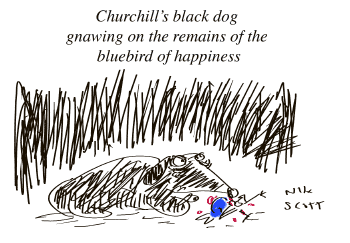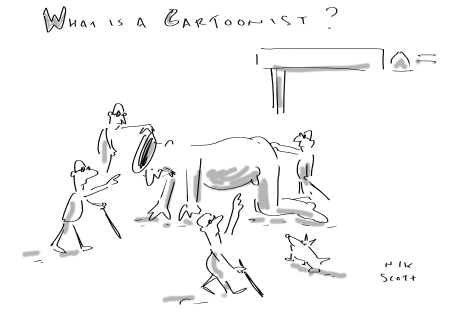
An Interview with Nik Scott from http://david-wasting-paper.blogspot.com
What is your favorite pen to use?
N: I use a Rotring fountain pen with Noodler’s ink or a Zig felt tip if I’m drawing on paper but most of my work is done on computer with a Wacom Cintiq. For very fine work I use various dip pen nibs but their model numbers are written too small for me to read so I can't pass them on.
Do you draw in pencil first and if so do you use a standard pencil or a mechanical one?
N: No, I just let the lines fall where they may. This is because I'm very impatient. I do work out a thumbnail first but that's in pen too.
Do you do your coloring by hand or on the computer?
N: Both. However coloring by hand is quicker and much more fun.
If you do your coloring by hand, what do you use?
N: Watercolors (mostly W&N or Maimeri Blu) with a DaVinci series 35 no 7 brush.
What type of paper do you use?
N: I use simple lay out paper for line drawings. For watercolor I use a 'pen n' wash' paper (Draw & Wash by Art Spectrum). I don't like the chalky surface of watercolor paper.
What thing(s) do you hate to draw?
N: The inside of clocks. Bicycles. Waterfalls.
Do you buy your supplies from big chain art store catalogues/websites or a local one that you physically go to?
N: Both, but mostly from websites. I'm in Australia and I often buy from the UK where our dollar currently buys more. Postage from the US is too prohibitive. Jackson’s Art Supplies and Bromley Art Supplies are my favourite stores in the UK.
Are there any rituals that you do before starting to draw?
N: I spend a little while doodling while reading the papers and staring into space. This either gets me in the zone or sends me to sleep.
Do you listen to music while you draw and if so what genre?
N: I work in silence, as I can never find the right CD in the right case at the right time.
Did you read comics as a kid and if so what was your favorite?
N: I grew up in the UK and enjoyed all the usual UK comics like Eagle and Beano. However I'd go out of my way to find DC comics and was a big fan of all things Superman, Action and World's Finest etc. My father had several Feiffer collections and it was those that really tickled me the most.
What is or was your favorite comic strip?
N: I don't have one now. My favourite used to be 'The Fosdyke Saga' by Bill Tidy. Later on my favourites were all from the Underground comics. I especially loved the work of Willy Murphy and Justin Green.
What was your favorite book as a child and do you still own a copy of it?
N: I was very fond of a particular Babar book about Babar visiting The Island of the Birds. The drawings were superb. Sadly I lost my copy and I believe it's now a rarity.
Did you have any formal art training and if so where did you receive it?
N: I went to the National Art School in Sydney, Australia. That mostly was life drawing. I also did a graphics course (pre-computers) run by seedy old ex advertising men who only ever talked to the women in the class.
Do you feel that the Internet is a blessing or a curse?
N: A blessing. I can now sell my cartoons everywhere. Before I only sold within Australia.
Did either of your parents draw?
N: My father used to draw cartoons to spice up his letters. He inspired me as did a painter friend of his named Paul Maze. I was exposed to a lot of Maze's work. He drew several sketches for me and I'd marvel at the speed, simplicity and accuracy of his line and would try to copy it.
Who in your life is/was the most supportive of your art?
N: Me.
Do you keep a sketchbook?
N: Yes, always. I guard it fiercely as it has lots of terrible drawings in it. Friends invariably pick it up and say, “what's this meant to be?”
Have you ever taught cartooning/drawing and if so did you enjoy the experience?
N: It's not my strong point. Sometimes I teach the children of friends. Next time I see them they've given up drawing completely.
Do you feel that talent or passion is more important in drawing?
N: Talent comes from passion.
Do you collect anything and if so what?
N: I'm not a collector but I have somehow ended up with almost every cartoon book ever printed. I never look at them anymore. My mission now is to somehow unload them at a profit before I die.
N: If you were an animated cartoon character who do you think you would be?
Barney Rubble.
Are you a righty or lefty?
N: A righty.
If you weren't an artist what would you want to do for work?
N: Anything that allows me to work from home and spend my life with my wife and daughter. I've spent my time in the regular workforce and find my family's company preferable to that of work colleagues and bosses.
In one or two sentences describe your drawing area.
N: An upstairs room with windows on three sides and views over the hills. Two workstations, one with computer/Cintiq, the other with paints and paper.
Do you play any musical instruments?
N: I used to play the guitar and trumpet and put in many hours enthusiastically playing 12-bar blues with other musically challenged friends. I pawned the guitar and never looked back.
If you could give one piece of advice to someone who wants to pursue drawing as a career what would it be?
N: I'd say 'Go for it'. However I'd also say, “Work in real job for a while to save up for the right computer equipment etc.” I'd then go on to point out that it's the cartoonists who can market themselves that get the big bucks.
Who is your favorite artist?
N: Bosch. He's still ahead of his and our times.

An Interview with Nik from http://the-cartoon-fiend.blogspot.com
Sunday, April 30, 2006
Friends of the Fiend 14: Nik Scott
CF. Hello, Nik.
NS. Hello Mr Fiend
CF. Okay, what are your current projects, anything exciting in the pipeline - that you can tell us about?
NS. I've just published a collection of my strips at lulu called Web Junkie, so i'm attempting to market that. I'm working on a couple of book projects. I don't want to talk about them as the more I talk about my projects the sillier they sound.
CF. Did you always want to be a cartoonist, and set out to become one, or was it a gradual process?
NS. I fell in love with cartooning from seeing my father add little sketches to his letters. I started to draw cartoons at the age of eight when i did a weekly strip at school. I always managed to sit next to other cartoonists or artists in class and spent most of my schooldays 'duelling toons'. I spent many years self-publishing a series of angry raw mini-comix that I hawked around to bookshops. One bookshop used to stick my weekly editorial cartoon in its front window (often upside down) and a magazine editor waiting for a bus outside noticed my it and offered me a regular job. That was the beginning of my professional career. I'd never realised i could get paid for doing something that i did compulsively anyway. I then spent several years working part time, and going to art school before becoming a full-time cartoonist.
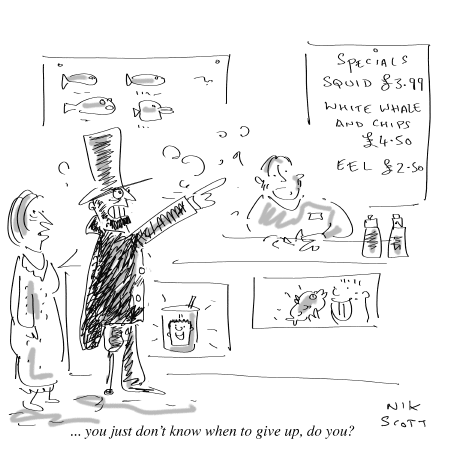
CF. The work you do at the moment, can you tell us something about the process?
NS. I have 'think' days and 'draw' days. Mornings are fresher. If i have time i like to have a think the night before and allow my subconscious to come up with the gags while i sleep. On a 'think' day i doodle in silence on a cheap A4 Layout pad, with a rotring artpen while slumped in an ergonomically unsound armchair. Sometimes the doodles guide the gag. I draw and render all my cartoons directly on the computer via my wacom tablet and Painter/Photoshop software. I love drawing with the computer. I don't miss having inky fingers, and I don't miss waiting for scanners to warm up.
CF. Is the cartoonist a proper artist? I mean, does cartooning have the same cultural impact as some other artforms, in your opinion?
NS. Cartoons are more 'throw away' than the Mona Lisa, but they're just as valid in their own way. They are also funnier than the Mona Lisa, but arguably not as funny as Le Dejeuner sur L'Herbe.
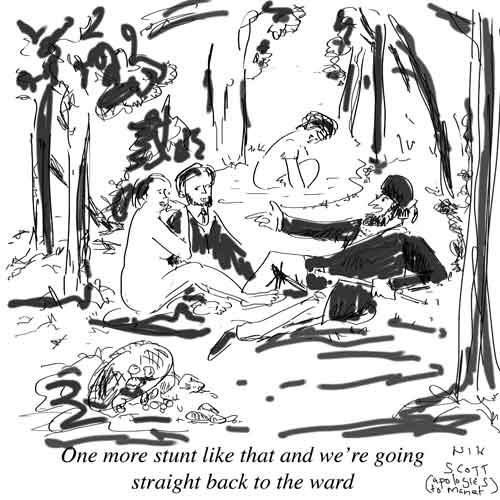
There's an archive of Nik's political cartoons at Daryl Cagle's Professional Cartoonists Index.
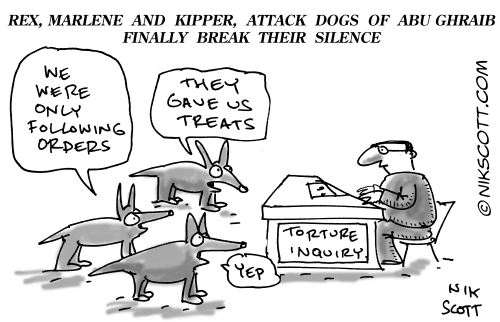
CF. Is there any other area of cartooning you'd like to work in, if you can find the time?
NS. Part of me wants to learn to animate but the lazy part of me says, 'No way, are you nuts, you freak?!'
CF. Who were your major artistic influences?
NS. My father initially, and then I discovered his Feiffer collection, which opened up a major cartoon addiction. Bill Tidy, Larry, Gahan Wilson, Kurtzman, Crumb, Shelton, Michael Leunig, Mary Leunig, S.Gross, Mary Wilshire, Lee Marrs, Justin Green, Frank Stack, Nicolas Bentley, Searle, Jenny Coopes, Steadman, Quentin Blake, Frank Dickens, Leo Baxendale, Kliban, McGill and Poelsma, Posy Simmonds, Bretecher, Sempe, Groening, Eisner,Aragones,Trudeau are just some of the many hundreds of cartoonists i continue to worship and that immediately spring to mind.
CF. Who was/is your favourite cartoonist/writer, of all time?
NS. That'd have to be Larry (Terence Parkes). He nails the issue in the simplest, funniest, and kindest manner possible.
CF. There's a lot of talk about a new 'paper-less future' and 'newdigital reading habits', do you think this will affect cartooning,at some point.
NS. People like cartoons, rather than the material that cartoons are drawn on. There will always be a place for cartoons in, or on, whatever the new medium happens to be.
CF. If you had the time, and you were helicoptered in to work on anything you chose, any publication, strip, panel, character, book, show, what would you like to work on?
NS. I'd like to do something for kids TV - Something for toddlers. I'd loved to have worked on Sesame Street. I could think of nothing cooler than writing for The Count.
CF. Is there anything you'd rather be?
NS. I'd like to be the kind of cartoonist who doesn't have to pay attention to the business side. I love cartooning, and i've got millions of ideas i want to work on, but I loathe marketing as it's time consuming, and takes me away from the creative process.
CF. Thank you for visiting with us.
NS. Thanks for having me.
